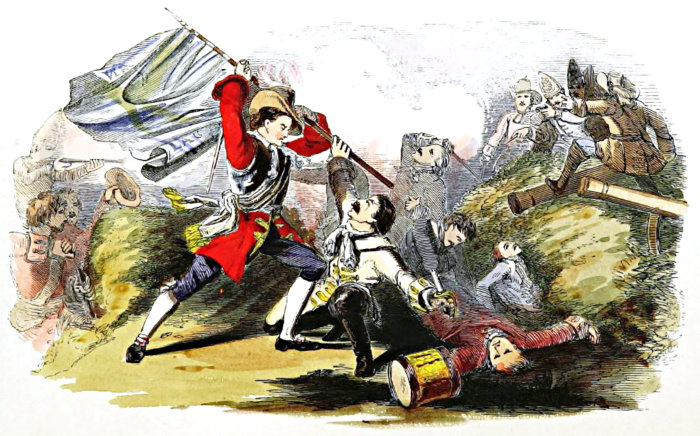Sir Robert Douglas, 3rd of Glenbervie
General Sir Robert Douglas, 3rd Bart of Glenbervie, Kincardine Baronetcy (Second
creation) (K 1692), colonel of
the Royal Scots (Regiment
de Douglas), 1690-1692.
On the 14th of August 1634 Mr. Douglases son James, designed
of Ardit, was served heir to him in his lands of Stonypath, Langtoun,
Dubend, tenement in Edinburgh, Broomholes, and acres in Scurrbank.
Anne, daughter and. heiress of James Douglas of Stonypath and Airdit,
married Sir William Douglas, second baron of Glenbervie (descended
from the Earls of Angus), who thus acquired James Douglas's lands.
Their only son, Sir Robert Douglas of Glenbervie, commanded the
Royal Scots at the battle of
Steinkirk in 1692, where he fell. The title then devolved on his
cousin, Sir Robert Douglas, who changed the name ' Airdit ' to '
Glenbervie,' which, however, was afterwards displaced by the
original designation. Sir Robert Douglas, author of the " Peerage
and Baronage of Scotland, was the representative of this family.
The Duke of Schomberg, who had been appointed Colonel of the
Royal Scots shortly after King William’s accession, was killed at
the battle of the Boyne. He was succeeded in the command of the
regiment by Sir Robert Douglas, of Glenbervie, second cousin of the
Earl of Dunbarton, who
was later to command the regiment.
 |
| Sir Robert Douglas of Glenbervie, Colonel of the Royal
Regiment of Foot, killed at the Battle of Steenkirk, July
24th, 1692. |
 |
This silver centre piece is held at the Regimental
Headquarters of the Royal Scots, in Edinburgh Castle.
It
depicts Sir Robert.
See notes. |
At the battle of Steinkirk, 1692, the
standard of the regiment being taken, Sir Robert jumped over a hedge
into the midst of the enemy, seized it from the officer in whose
charge it was, threw it back to his own men, but fell, pierced with
many wounds.
Lord George Hamilton, son of William Duke of
Hamilton, and nephew of the Earl of Dunbarton, was then appointed,
on the 1st August 1692, Colonel of the Royal Scots.
On his death in 1692, Sir Robert Douglas, 3rd of Glenbervie, was succeeded by his cousin, Sir Robert
Douglas of Ardit, grandson of Rev Dr George Douglas, rector of
Stepney..
See also:
Notes:
1. The Royal Scots' centrepiece is, in 2017, on loan to
the 1st Battalion The Royal Regiment of Scotland, which is based in
Northern ireland.
Col Robert Watson writes:
"A plate fund was established by the
1st Battalion in 1878 and, soon afterwards, the decision was taken
to purchase a centrepiece. In 1883 a design and estimate was
obtained from Hunt and Rockall of Bond Street, London. Designs sent
to Barbados in January 1884 were approved, but the work was put in
abeyance due to the imminent move to Bechuanaland, and the order was
not confirmed until 1890. It was completed in August 1892 at a cost
of around £600, at least £65,000 today - if you were able to find a
silversmith to make it. The centrepiece (see Front Cover and left on
next page) stands some 40 inches high and was designed to illustrate
the history of the Regiment up to that time. At the top is a group
representing Sir Robert Douglas's recovery of the Colour at
Steenkirke in 1692. Round the base are four figures illustrating the
uniforms and weapons of 1625, 1685, 1742 and 1813. Each figure can
be detached and mounted separately on its own ebony plinth. Between
the figures are four panels, chased in relief, representing four of
the Regiments most celebrated battles: Blenheim, 1704, where both
the 1st and 2nd Battalions distinguished themselves; and three of
the great battles of the Napoleonic wars, in each of which the 3rd
Battalion played a major role, Corunna, 1809, San Sebastian, 1813
(where the storming twice, the second time successfully, of a breach
in the City walls is generally considered to be the Regiment's
greatest single feat of arms up until that point) and Quatre Bras
(the prelude to Waterloo), 1815. The centre pillar has four Sphinx
at its base marking the 2nd Battalion's success in the Egyptian
campaign against Napoleon in 1801.."
Any contributions will be
gratefully accepted
Errors and Omissions
|
|
The Forum
|
|
What's new?
|
|
We are looking for your help to improve the accuracy of The Douglas
Archives.
If you spot errors, or omissions, then
please do let us know
Contributions
Many articles are stubs which would benefit from re-writing.
Can you help?
Copyright
You are not authorized to add this page or any images from this page
to Ancestry.com (or its subsidiaries) or other fee-paying sites
without our express permission and then, if given, only by including
our copyright and a URL link to the web site.
|
|
If you have met a brick wall
with your research, then posting a notice in the Douglas Archives
Forum may be the answer. Or, it may help you find the answer!
You may also be able to help others answer their queries.
Visit the
Douglas Archives Forum.
2 Minute Survey
To provide feedback on the website, please take a couple of
minutes to complete our
survey.
|
|
We try to keep everyone up to date with new entries, via our
What's New section on the
home page.
We also use
the Community
Network to keep researchers abreast of developments in the
Douglas Archives.
Help with costs
Maintaining the three sections of the site has its costs. Any
contribution the defray them is very welcome
Donate
Newsletter
If you would like to receive a very occasional newsletter -
Sign up!
Temporarily withdrawn.
|
|
|
|
|
|
|
|


